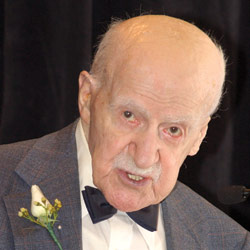The birth of modern quality can arguably be pinpointed to the mid-1920s. Walter A. Shewhart, a statistician at Western Electric, began to focus on controlling processes, making quality relevant not only for finished products, but for the processes that created those products. Shewhart recognized that all processes yield data that could be analyzed using statistical techniques to determine if a process is stable and in control. His work laid the foundation for statistical control charts, a landmark modern-day tool that would revolutionize the management of processes and launch generations of quality experts.
World War II was a watershed event for the quality revolution. Prior to the war, the quality movement had made incremental progress, but progress was hampered by the lack of communication among companies. There was also no professional society oriented to quality. The societies of that period were focused on mechanical engineering, etc., and more on efficiency and productivity. But World War II had a profound effect on the approach for the management for quality.
 As part of U.S. efforts to harness the civilian economy to the war effort, a branch of the War Production Board focused on training courses for statistical tools such as control charts and sampling plans, which had evolved with the Bell System from the 1920s. The Department of Defense (DoD), in its Lend Lease program, procured the services of leading experts in the “quality field” to conduct this work. Joseph M. Juran and W. Edwards Deming (both mentored by Walter Shewhart) were just two who worked to train civilian suppliers to the wartime effort.
As part of U.S. efforts to harness the civilian economy to the war effort, a branch of the War Production Board focused on training courses for statistical tools such as control charts and sampling plans, which had evolved with the Bell System from the 1920s. The Department of Defense (DoD), in its Lend Lease program, procured the services of leading experts in the “quality field” to conduct this work. Joseph M. Juran and W. Edwards Deming (both mentored by Walter Shewhart) were just two who worked to train civilian suppliers to the wartime effort.
Training and the use of statistical tools led to significant improvement through robust processes. This led to the formation of quality control engineering and quality experts. Many companies formed quality departments to combine the efforts of these specialists and focus the efforts of training initiatives, data analysis, statistical process control and improvement activities. Another notable outcome was the formation of a society dedicated to promotion of quality and to the quality profession. (See the sidebar below.)
By far, the most important event that followed the war was the Japanese quality revolution. The U.S. DoD asked Juran and Deming, two of the emerging quality giants of the era, to work with Japan, and, partially due to their efforts, Japan committed to becoming an economic superpower. Deming taught the Shewhart control charts and the Plan-Do-Check-Act, while Juran focused on managing for quality and the methodology of annual quality improvement.
The Japanese quality revolution took three decades and brought great benefits to American consumers—but at the expense of other parts of the economy. Manufacturers lost market share, jobs were exported and the national trade balance was upset. Although it took some time for American companies to “wake up,” evidence exists that, in most cases, the quality gap between Japanese and American products is insignificant.
The quality strategies of today are focused on a total quality approach, which was fundamental to the teachings of Juran, Deming and Armand V. Feigenbaum. However, it was the Japanese companies who embraced the concept. The Toyota Production System is a great example of the integration of these concepts with the use of focused tools. Many American companies are busy deploying this methodology, but it takes time.
As the first decade of the 21st century is about to close, the quality movement is still maturing. The new quality systems have evolved beyond the foundations laid by Juran, Deming, Feigenbaum and the early Japanese practitioners of quality like Ishikawa, Shingo and Taguchi. The one thing we have come to realize is that quality is a journey, not a destination! We can expect more development and challenges in the decades to come.
The Giants of Modern Quality
Walter A. Shewhart (1891-1967) had a most profound impact on modern quality. He joined Western Electric in Hawthorne, Illinois, and his pioneering works in statistical process control would alter the course of industrial history. Shewhart’s principle was that bringing a process into a state of statistical control would allow the discovery and elimination of causes of variation, leading to greater efficiency and effectiveness. With his first published book, Economic Control of Manufactured Product, this important concept was given to the world and was the birth of the modern scientific study of process control. Arguably, his most important contribution was mentoring other quality giants, such as Dr. Joseph M. Juran, Dr. W. Edwards Deming, and a host of others who would have a profound impact on society as a whole.
After graduating from the University of Minnesota, Joseph M. Juran (1904-2008) worked at Western Electric’s famous Hawthorne Plant near Chicago, where he studied with Walter Shewhart. He left Western Electric after World War II to begin a 60+ year career in research, lecturing, consulting and publishing of more than 15 technical books and articles too numerous to count. He lectured and taught quality management to tens of thousands in more than 40 countries, and his first book, Quality Control Handbook, was a landmark work that is still relevant today. His work with Japanese industry was instrumental in their entrance on the world stage as a competitor of quality products and services. For his contributions, Japan named a temple in his honor. Dr. Juran was a founding member of the American Society for Quality.
W. Edwards Deming (1900-1993) also worked and trained with Dr. Shewhart at Western Electric and had great success using his principles. After World War II, the U.S. Department of Defense asked Deming to work with Japan on reconstruction efforts. He refused royalties from courses and lectures, insisting that all proceeds be used to help the Japanese people. He is considered a national folk hero in Japan and founder of their third wave of industrial revolution. Their top quality award is named The Deming Prize. Dr. Deming authored more than 200 papers, articles and books, but is best known for the NBC News white paper “If Japan Can, Why Can’t We?” Broadcast in 1980, it described how the Japanese captured the auto and electronics markets by practicing continual improvement and thinking of manufacturing as a whole system. The broadcast was credited with introducing the quality revolution to American managers.
After serving two terms in the U.S. Navy, Philip B. Crosby (1928-2001) worked for several aerospace firms before beginning a career at ITT. In 1979, he founded Philip Crosby Associates, where he served many organizations large and small. His management courses have been taught in many languages and in locations around the globe. Many quality experts are viewed as academics, but Crosby was considered a businessman, which explains why top executives flocked to his Quality College. Crosby believed that quality was a significant part of an organization and that senior managers must take active leadership roles. He also believed that quality professionals must become more knowledgeable and communicative about business. He is best known for the “Zero Defects” methodology, his 14 steps to improvement and the four absolutes of quality.
Dr. Armand V. Feigenbaum (1920- ) worked 26 years at General Electric before leaving to form his own company, General Systems. His landmark book Total Quality Control, published in 1951, is widely accepted around the world as a foundation for quality control. Feigenbaum was the founding chairman of the International Academy for Quality and is widely recognized as the father of Total Quality Management. He is also known for the concepts of the “hidden factory” and that “quality is what the customer says it is.” On September 29, 2008, President George W. Bush presented him with the National Medal of Technology and Innovation, the highest honor for technological achievement that can be bestowed by the president. iBi


